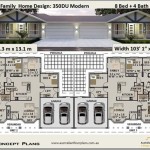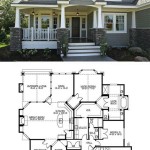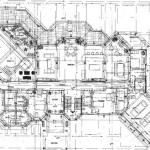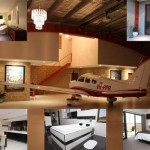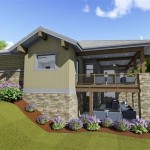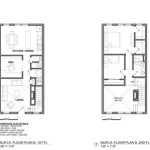Simple Bungalow House Design With Floor Plan 2 Bedroom
Bungalow house designs, characterized by their single-story structure, low-pitched roofs, wide eaves, and prominent front porches, have maintained enduring popularity. These designs offer a practical and aesthetically pleasing housing solution, particularly for smaller families, retirees, or individuals prioritizing accessibility and ease of maintenance. A two-bedroom bungalow effectively balances affordability, functionality, and comfort, making it an attractive option for a wide range of homeowners. The accompanying floor plan is crucial for visualizing the spatial arrangement and ensuring it aligns with individual needs and preferences.
The allure of a simple bungalow design lies in its uncomplicated structure and efficient use of space. Minimizing vertical construction simplifies the building process, reducing costs and construction time. The single-story layout eliminates the need for stairs, promoting accessibility for individuals with mobility limitations and making it easier to manage household chores. Furthermore, bungalows often feature open-concept living areas, fostering a sense of spaciousness and facilitating social interaction. The incorporation of natural light through strategically placed windows further enhances the living environment.
Designing a two-bedroom bungalow involves careful consideration of the floor plan to optimize space utilization and create a comfortable living environment. The layout typically incorporates a living room, kitchen, dining area, two bedrooms, and one or two bathrooms. The arrangement of these spaces should prioritize functionality and flow, ensuring easy movement throughout the house. The size and configuration of each room should be tailored to the specific needs and lifestyle of the occupants.
Key Point 1: Optimizing Space in a Two-Bedroom Bungalow Floor Plan
Efficient space utilization is paramount in a two-bedroom bungalow design. Given the limited square footage, maximizing every inch is essential to avoid a cramped or cluttered feeling. Open-concept designs, which combine the living room, kitchen, and dining area into a single, unified space, are a common strategy for creating a sense of spaciousness. This arrangement also promotes social interaction and allows for flexible furniture placement.
Storage solutions play a vital role in optimizing space. Built-in cabinets, shelves, and wardrobes can provide ample storage without occupying valuable floor space. Utilizing vertical space by installing shelves or cabinets that reach the ceiling can further enhance storage capacity. Multi-functional furniture, such as sofa beds or storage ottomans, can also contribute to space savings. Consideration should be given to under-bed storage solutions for optimizing bedroom organization.
The design of traffic flow is another crucial aspect of space optimization. Hallways should be minimized or eliminated to reduce wasted space. The layout should facilitate easy movement between rooms, avoiding bottlenecks or awkward transitions. Strategic placement of doors and windows can also contribute to a more efficient and functional floor plan.
Careful consideration of room sizes is imperative. While maximizing living space is desirable, ensuring adequate space for each bedroom is also essential. The master bedroom should be slightly larger than the second bedroom and should ideally include an en-suite bathroom or walk-in closet. The kitchen should be designed with sufficient counter space and storage to accommodate cooking and meal preparation activities.
Furthermore, the orientation of the bungalow on the lot can influence space utilization. Maximizing natural light by strategically placing windows and orienting the house to capture sunlight can create a brighter and more spacious feeling. Consider the placement of the porch and its potential impact on natural light entering the living spaces.
Key Point 2: Enhancing Functionality and Accessibility
Functionality and accessibility are key considerations in bungalow design, particularly given its popularity among older adults and individuals with mobility limitations. A single-story layout eliminates the need for stairs, making the house easily accessible to everyone. Wider doorways and hallways can further enhance accessibility for individuals using wheelchairs or walkers.
Universal design principles, which aim to create spaces that are usable by people of all ages and abilities, should be incorporated into the floor plan. This includes features such as lever-handled door hardware, grab bars in bathrooms, and adjustable-height countertops. These features enhance accessibility and make the house more comfortable and convenient for everyone.
The kitchen design should prioritize functionality and ergonomics. Countertops should be at a comfortable height for food preparation, and appliances should be easily accessible. A well-organized kitchen with ample storage can make cooking and meal preparation more efficient and enjoyable. Consider incorporating features such as pull-out shelves and lazy Susans to maximize accessibility to stored items.
Bathroom design should also prioritize functionality and accessibility. Walk-in showers with grab bars and non-slip flooring are essential features for creating a safe and accessible bathroom. Consider incorporating a comfort-height toilet and a roll-under sink for added convenience. Proper lighting is crucial for ensuring visibility and safety in the bathroom.
The outdoor spaces surrounding the bungalow should also be designed with accessibility in mind. Ramps or gradually sloping walkways can provide easy access to the porch and yard. Consider incorporating features such as raised garden beds or accessible seating areas to make the outdoor spaces more enjoyable for everyone.
Key Point 3: Balancing Privacy and Social Interaction
Balancing privacy and social interaction is a crucial aspect of bungalow design. While open-concept living areas promote social interaction, it is also important to provide private spaces for relaxation and retreat. The floor plan should be designed to create a harmonious balance between these two needs.
The bedrooms should be located away from the main living areas to ensure privacy and minimize noise disruption. Consider placing the bedrooms at the back of the house or in a separate wing. Soundproofing measures, such as insulated walls and doors, can further enhance privacy in the bedrooms.
The bathrooms should be located near the bedrooms for convenience, but they should also be easily accessible from the main living areas. Consider incorporating a powder room or half-bath near the living room to minimize traffic through the bedrooms. Strategic placement of bathrooms can ensure both privacy and convenience for residents and guests.
The layout should consider visual privacy. Carefully positioned walls and windows can offer privacy from neighbors and passersby. Landscaping can also provide a natural barrier to enhance privacy. Placement of outdoor living spaces, such as patios and decks, should also consider visual privacy.
Consider incorporating a flexible space that can be used as a home office, guest room, or hobby room. This space can provide additional privacy and flexibility, allowing the house to adapt to changing needs. French doors or sliding doors can be used to create a visual separation while still allowing light and air to flow through.
Zoning within the open-concept living area is important to delineate distinct spaces. Use of rugs, furniture arrangement, or changes in flooring can help define the living room, dining area, and kitchen within the overall space. These subtle cues can create a sense of order and visual separation without compromising the open feel.
Ultimately, the success of a two-bedroom bungalow design hinges on a well-considered floor plan that effectively balances space optimization, functionality, accessibility, privacy, and social interaction. Careful planning and attention to detail are essential for creating a comfortable, convenient, and aesthetically pleasing living environment that meets the specific needs and lifestyle of the occupants.

Peralta 2 Bedroom Bungalow House Design Pinoy Eplans Small Plans

Modern Style With 2 Bed 1 Bath House Plans Beautiful Es Design

Stunning 2 Bedroom House Plans 19 For Your Decorating Home Ideas With Bungalow Floor Modular Condo

Katrina Stylish Two Bedroom House Plan Pinoy Eplans 2 Design Plans

Two Bedroom Small House Design Shd 2024030 Pinoy Eplans Plans Floor

Two Bedroom Bungalow House Plan 80625pm Architectural Designs Plans

Free Bungalow House Designs And Floor Plans With 2 Bedrooms 3 4 Contemporary Design

Bungalow House Plans 6 8 With Two Bedrooms Engineering Discoveries

Two Bedroom Bungalow House Design Master En Suite Muthurwa Com 2 Plans

Luxury 2 Bedroom Elevated House Design Pinoy Eplans
Related Posts

